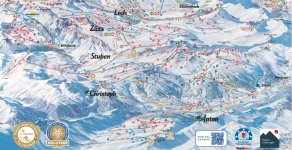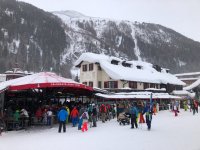ChrisC
Well-known member
Planning a trip to Austria (and W. Switzerland) involved reviewing old trip photos, so I thought I would post some.
After skiing Engleberg and Andermatt, I picked up my brother at Zurich airport, and we went to the Arlberg (Austria's largest connected ski complex)—staying at a half-board inn in St. Anton for a week. The largest villages in the Ski Arberg complex are St. Anton and Lech (both make good bases). Stuben might be the best value since it is central to Zurs, St. Anton, near Lech, and has excellent home slopes - with cheaper lodging options.
Ski Arlberg Map

Our first ski day was a storm day with about 6 inches of new snow, but it is never optimal to begin exploring a Euro ski megaplex in a potential whiteout. However, you can use the Arlberg website's ski cams to look for areas of visibility. Also, the lower slopes of St. Anton, St. Christoph, and Stuben have decent tree protection (highlighted in red).

After some steep, powdery shots off the Galzigbahn, there were indications of some OK visibility in Stuben, so we headed off there, gradually working our way back to St. Anton.

Due to the NordStau weather phenomenon, snowfall in the early season of 2018/19 was exceptional in Austria and Western Switzerland.
The Nordstau is a type of Stau effect that occurs when cold, moist air masses collide with the northern side of the Alps, causing heavy precipitation. The Nordstau is one of several types of Stau effect storms that occur in the Alps, including the Nordweststau, Sudstau, Weststau, and Retour d'est. The direction of the prevailing wind determines which side of the Alps receives the most precipitation. The Nordstau is a well-known storm type that can cause significant snowfall in the northern Alps, which include parts of Austria, Switzerland, and France. These events can last several days, especially when there is a strong northerly flow. The chances of a Nordstau increase when the jet stream has a more north-south pattern

 opensnow.com
opensnow.com
Social media posts like the one below were shared in December/January, with multiple meters of snow falling; bases were near 500cm+ at altitude and 200cm+ in the ski villages.

First night in St. Anton. The original Tyrolean village, after which Vail modeled itself.

Finally, I stopped for some photos mid-morning - ascending to the summit of Stuben. Using a combination of some piste markers or rocks, it was not hard to take advantage of the 6-12" of new snow


Lots of fun trees to ski coming into Stuben village.


We are skiing the woods and open areas near the Galzigbahn on our way down to St. Anton. Rendl is the mountain in the background.

Checking out the infamous St. Anton Apres Ski - The Krazy Kangaroo. No one is outside dancing on tables today!

St. Anton base. Rendl Gondola in the background.

I never considered St. Anton a storm-day mountain, but it skied really well on the lower half. St. Anton's slopes proper are mostly SE and S facing, but with the record snow bases, new snow, and cold temps (0F-25F) for the week, it did not matter.
After skiing Engleberg and Andermatt, I picked up my brother at Zurich airport, and we went to the Arlberg (Austria's largest connected ski complex)—staying at a half-board inn in St. Anton for a week. The largest villages in the Ski Arberg complex are St. Anton and Lech (both make good bases). Stuben might be the best value since it is central to Zurs, St. Anton, near Lech, and has excellent home slopes - with cheaper lodging options.
Ski Arlberg Map
Our first ski day was a storm day with about 6 inches of new snow, but it is never optimal to begin exploring a Euro ski megaplex in a potential whiteout. However, you can use the Arlberg website's ski cams to look for areas of visibility. Also, the lower slopes of St. Anton, St. Christoph, and Stuben have decent tree protection (highlighted in red).
After some steep, powdery shots off the Galzigbahn, there were indications of some OK visibility in Stuben, so we headed off there, gradually working our way back to St. Anton.
Due to the NordStau weather phenomenon, snowfall in the early season of 2018/19 was exceptional in Austria and Western Switzerland.
The Nordstau is a type of Stau effect that occurs when cold, moist air masses collide with the northern side of the Alps, causing heavy precipitation. The Nordstau is one of several types of Stau effect storms that occur in the Alps, including the Nordweststau, Sudstau, Weststau, and Retour d'est. The direction of the prevailing wind determines which side of the Alps receives the most precipitation. The Nordstau is a well-known storm type that can cause significant snowfall in the northern Alps, which include parts of Austria, Switzerland, and France. These events can last several days, especially when there is a strong northerly flow. The chances of a Nordstau increase when the jet stream has a more north-south pattern

Alps Storm Type #1: The Nordstau | OpenSnow
During the winter, the Alps experience heavy snowfall due to several weather patterns and storm tracks. Five key phenomena,...
Social media posts like the one below were shared in December/January, with multiple meters of snow falling; bases were near 500cm+ at altitude and 200cm+ in the ski villages.
First night in St. Anton. The original Tyrolean village, after which Vail modeled itself.
Finally, I stopped for some photos mid-morning - ascending to the summit of Stuben. Using a combination of some piste markers or rocks, it was not hard to take advantage of the 6-12" of new snow
Lots of fun trees to ski coming into Stuben village.
We are skiing the woods and open areas near the Galzigbahn on our way down to St. Anton. Rendl is the mountain in the background.
Checking out the infamous St. Anton Apres Ski - The Krazy Kangaroo. No one is outside dancing on tables today!
St. Anton base. Rendl Gondola in the background.
I never considered St. Anton a storm-day mountain, but it skied really well on the lower half. St. Anton's slopes proper are mostly SE and S facing, but with the record snow bases, new snow, and cold temps (0F-25F) for the week, it did not matter.

